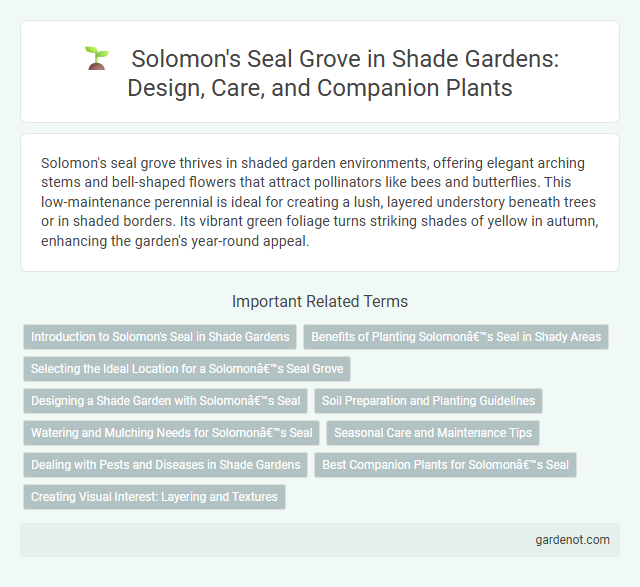Solomon's seal grove thrives in shaded garden environments, offering elegant arching stems and bell-shaped flowers that attract pollinators like bees and butterflies. This low-maintenance perennial is ideal for creating a lush, layered understory beneath trees or in shaded borders. Its vibrant green foliage turns striking shades of yellow in autumn, enhancing the garden's year-round appeal.
Introduction to Solomon's Seal in Shade Gardens
Solomon's seal (Polygonatum spp.) thrives in shade gardens, offering graceful arching stems with dangling, bell-shaped flowers that attract pollinators. Its ability to tolerate deep shade and moist, well-drained soil makes it a valuable groundcover for woodland or shaded borders. The plant's striking variegated foliage and robust growth habit enhance the texture and depth of dense shade garden landscapes.
Benefits of Planting Solomon’s Seal in Shady Areas
Solomon's seal thrives in shaded garden environments, offering excellent ground cover that suppresses weeds and maintains soil moisture. Its arching stems and elegant, tubular white flowers enhance aesthetic appeal while providing habitat and forage for pollinators like bees. The plant's tolerance to low light conditions and resistance to deer make it a low-maintenance choice for enriching shade gardens with biodiversity and texture.
Selecting the Ideal Location for a Solomon’s Seal Grove
Choosing the ideal location for a Solomon's seal grove requires a shady, well-drained spot with rich, humus-laden soil that mimics its natural woodland habitat. These plants thrive under the canopy of deciduous trees where they receive dappled sunlight and protection from harsh afternoon sun, ensuring vigorous growth and vibrant foliage. Ensuring consistent moisture without waterlogging is crucial to maintain the health and longevity of Solomon's seal colonies in a shade garden.
Designing a Shade Garden with Solomon’s Seal
Solomon's seal thrives in shaded, woodland garden settings, making it an ideal choice for designing a serene shade garden with layered textures and graceful arching stems. This perennial's tolerance for moist, well-drained soils complements ferns, hostas, and other shade-loving plants, creating a lush understory effect. Incorporating Solomon's seal in a shade garden enhances biodiversity by attracting pollinators and providing seasonal interest with its delicate white bell-shaped flowers and vibrant fall foliage.
Soil Preparation and Planting Guidelines
Solomon's seal thrives in well-drained, loamy soil enriched with organic matter to mimic its natural woodland habitat. Before planting, loosen the soil to a depth of 8-10 inches and incorporate compost or aged leaf mold to improve moisture retention and nutrient content. Space rhizomes 1 to 2 feet apart, planting them 2 to 3 inches deep with the growing tips pointed upward to ensure optimal root development and growth.
Watering and Mulching Needs for Solomon’s Seal
Solomon's seal thrives in consistently moist, well-drained soil, requiring regular watering especially during dry spells to maintain optimal growth. Applying a 2-3 inch layer of organic mulch such as shredded leaves or bark helps retain soil moisture, regulate temperature, and suppress weeds. Proper mulching also enriches the soil as it decomposes, supporting the plant's health in shady garden environments.
Seasonal Care and Maintenance Tips
Solomon's seal thrives in shaded garden areas, requiring consistent moisture and well-drained soil for optimal growth during spring and summer. Regularly removing dead foliage in late fall helps prevent disease and promotes healthy regrowth in the following season. Applying a layer of mulch around the base conserves soil moisture and protects roots from frost damage during winter months.
Dealing with Pests and Diseases in Shade Gardens
Solomon's seal in shade gardens is susceptible to common pests such as slugs, aphids, and sawfly larvae, which can cause leaf damage and reduce plant vigor. Effective pest management includes regular inspection, using organic insecticidal soap, and encouraging beneficial insects like ladybugs to control aphid populations naturally. Employing mulch to retain moisture and removing diseased foliage promptly helps prevent fungal infections, ensuring a healthy Solomon's seal grove.
Best Companion Plants for Solomon’s Seal
Best companion plants for Solomon's Seal include ferns, hostas, and astilbes, which thrive in similar shady, moist conditions. These shade-loving perennials enhance the garden's texture and color contrast, with ferns providing feathery foliage and hostas offering broad, lush leaves. Astilbes add delicate, plume-like flowers that complement Solomon's Seal's arching stems and bell-shaped blooms, creating a harmonious and visually appealing shade garden.
Creating Visual Interest: Layering and Textures
Solomon's seal grove creates visual interest through strategic layering of its arching stems and variegated leaves that add depth and texture to shade gardens. The plant's delicate, dangling white flowers contrast beautifully with its broad, patterned foliage, enhancing the multi-dimensional effect. Combining Solomon's seal with ferns and hostas intensifies texture variations, resulting in a lush, dynamic understory.
Solomon’s seal grove Infographic

 gardenot.com
gardenot.com